Papers by Giulianna Borges
This is an Open Access article distributed under the terms of the Creative Commons Attribution Li... more This is an Open Access article distributed under the terms of the Creative Commons Attribution License
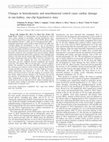
Sympathovagal balance and baroreflex control of heart rate (HR) were evaluated during the develop... more Sympathovagal balance and baroreflex control of heart rate (HR) were evaluated during the development (one and four weeks) of one kidney, one clip (1K1C) hypertension in conscious mice. The development of cardiac hypertrophy and fibrosis was also examined. Overall variability of systolic arterial pressure (AP) and HR in the time domain and baroreflex sensitivity were calculated from basal recordings. Methyl atropine and propranolol allowed the evaluation of the sympathovagal balance to the heart and the intrinsic HR. Staining of renal angiotensin II in the kidney and plasma renin activity (PRA) were also evaluated. One and four weeks after clipping, the mice were hypertensive and tachycardic, and exhibited elevated sympathetic and reduced vagal tone. The intrinsic HR was elevated only one week after clipping. Systolic AP variability was elevated while HR variability and baroreflex sensitivity were reduced one and four weeks after clipping. Renal angiotensin II staining and PRA were ...
The Faseb Journal, Apr 1, 2007
The Faseb Journal, Apr 1, 2009
The Faseb Journal, Apr 1, 2009
The Faseb Journal, Apr 1, 2009
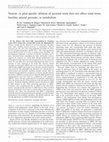
The renin-angiotensin system (RAS), known for its roles in cardiovascular, metabolic, and develop... more The renin-angiotensin system (RAS), known for its roles in cardiovascular, metabolic, and developmental regulation, is present in both the circulation and in many individual tissues throughout the body. Substantial evidence supports the existence of a brain RAS, though quantification and localization of brain renin have been hampered by its low expression levels. We and others have previously determined that there are two isoforms of renin expressed in the brain. The classical isoform encoding secreted renin (sREN) and a novel isoform encoding intracellular renin (icREN), the product of an alternative promoter and first exon (exon 1b). The differential role that these two isoforms play in cardiovascular and metabolic regulation remains unclear. Here we examined the physiological consequences of neuron-and glia-specific knockouts of sREN by crossing mice in which the sREN promoter and isoform-specific first exon (exon-1a) is flanked by LoxP sequences (sREN flox mice) with mice expressing Cre-recombinase controlled by either the neuron-specific Nestin promoter or the glia-specific GFAP promoter. Resulting offspring exhibited selective knockout of sREN in either neurons or glia, while preserving expression of icREN. Consistent with a hypothesized role of icREN in the brain RAS, neuron-and glia-specific knockout of sREN had no effect on blood pressure or heart rate; food, water, or sodium intake; renal function; or metabolic rate. These data demonstrate that sREN is dispensable within the brain for normal physiological regulation of cardiovascular, hydromineral, and metabolic regulation, and thereby indirectly support the importance of icREN in brain RAS function. blood pressure; energy; angiotensin; transgenic; knockout THERE IS A WEALTH OF EVIDENCE supporting the function of an intrinsic renin-angiotensin system (RAS) in the brain. Every component of the RAS is expressed in the brain, although the localization of renin remains challenging because its level of expression is very low (12). Despite a vast literature supporting the function of the brain RAS, the mechanisms and location of de novo angiotensin generation and action remain unclear. Renin activity was initially identified in rat and dog brains, and the presence of brain renin independent of its renal source was verified after bilateral nephrectomy (6-8).
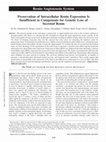
The primary product of the renin gene is preprorenin. A signal peptide sorts renin to the secreto... more The primary product of the renin gene is preprorenin. A signal peptide sorts renin to the secretory pathway in juxtaglomerular cells where it is released into the circulation to initiate the renin-angiotensin system cascade. In the brain, transcription of renin occurs from an alternative promoter encoding an mRNA starting with a new first exon (exon 1b). Exon 1b initiating transcripts skip over the classical first exon (exon 1a) containing the initiation codon for preprorenin. Exon 1b transcripts are predicted to use a highly conserved initiation codon within exon 2, producing renin, which should remain intracellular, because it lacks the signal peptide. To evaluate the roles of secreted and intracellular renin, we took advantage of the organization of the renin locus to generate a secreted renin (sRen)-specific knockout, which preserves intracellular renin expression. Expression of sRen mRNA was ablated in the brain and kidney, whereas intracellular renin mRNA expression was preserved in fetal and adult brains. We noted a developmental shift from the expression of sRen mRNA in the fetal brain to intracellular renin mRNA in the adult brain. Homozygous sRen knockout mice exhibited very poor survival at weaning. The survivors exhibited renal lesions, low hematocrit, an inability to generate a concentrated urine, decreased arterial pressure, and impaired aortic contraction. These results suggest that preservation of intracellular renin expression in the brain is not sufficient to compensate for a loss of sRen, and sRen plays a pivotal role in renal development and function, survival, and the regulation of arterial pressure. (Hypertension.
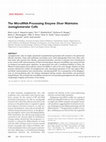
Juxtaglomerular cells are highly specialized myoepithelioid granulated cells located in the glome... more Juxtaglomerular cells are highly specialized myoepithelioid granulated cells located in the glomerular afferent arterioles. These cells synthesize and release renin, which distinguishes them from other cells. How these cells maintain their identity, restricted localization, and fate is unknown and is fundamental to the control of BP and homeostasis of fluid and electrolytes. Because microRNAs may control cell fate via temporal and spatial gene regulation, we generated mice with a conditional deletion of Dicer, the RNase III endonuclease that produces mature microRNAs in cells of the renin lineage. Deletion of Dicer severely reduced the number of juxtaglomerular cells, decreased expression of the renin genes (Ren1 and Ren2), lowered plasma renin concentration, and decreased BP. As a consequence of the disappearance of renin-producing cells, the kidneys developed striking vascular abnormalities and prominent striped fibrosis. We conclude that microRNAs maintain the renin-producing juxtaglomerular cells and the morphologic integrity and function of the kidney.
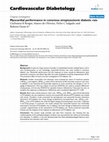
Background: In spite of a large amount of studies in anesthetized animals, isolated hearts, and i... more Background: In spite of a large amount of studies in anesthetized animals, isolated hearts, and in vitro cardiomyocytes, to our knowledge, myocardial function was never studied in conscious diabetic rats. Myocardial performance and the response to stress caused by dobutamine were examined in conscious rats, fifteen days after the onset of diabetes caused by streptozotocin (STZ). The protective effect of insulin was also investigated in STZ-diabetic rats. Methods: Cardiac contractility and relaxation were evaluated by means of maximum positive (+dP/dt max) and negative (-dP/dt max) values of first derivative of left ventricular pressure over time. In addition, it was examined the myocardial response to stress caused by two dosages (1 and 15 μg/kg) of dobutamine. One-way analysis of variance (ANOVA) was used to compare differences among groups, and two-way ANOVA for repeated measure, followed by Tukey post hoc test, to compare the responses to dobutamine. Differences were considered significant if P < 0.05. Results: Basal mean arterial pressure, heart rate, +dP/dt max and-dP/dt max were found decreased in STZ-diabetic rats, but unaltered in control rats treated with vehicle and STZ-diabetic rats treated with insulin. Therefore, insulin prevented the hemodynamic and myocardial function alterations observed in STZ-diabetic rats. Lower dosage of dobutamine increased heart rate, +dP/dt max and-dP/dt max only in STZ-diabetic rats, while the higher dosage promoted greater, but similar, responses in the three groups. In conclusion, the results indicate that myocardial function was remarkably attenuated in conscious STZ-diabetic rats. In addition, the lower dosage of dobutamine uncovered a greater responsiveness of the myocardium of STZ-diabetic rats. Insulin preserved myocardial function and the integrity of the response to dobutamine of STZ-diabetic rats. Conclusion: The present study provides new data from conscious rats showing that the cardiomyopathy of this pathophysiological condition was expressed by low indices of contractility and relaxation. In addition, it was also demonstrated that these pathophysiological features were prevented by the treatment with insulin.










Uploads
Papers by Giulianna Borges